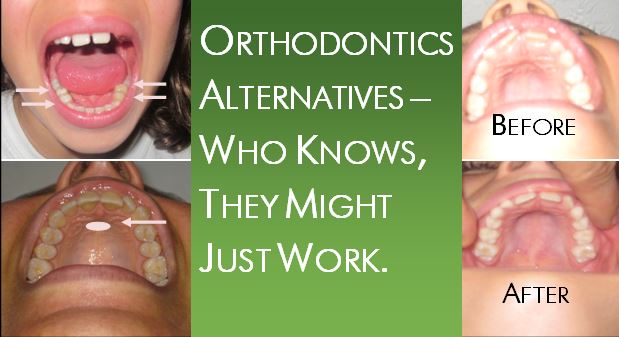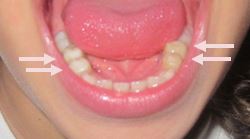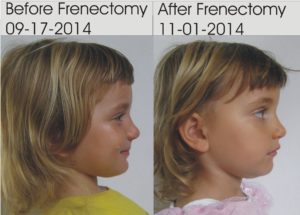Finding & Treating The Fundamental Cause of Orthodontic Issues – Cranial Structure
Fundamentally orthodontic issues come from the degradation of the human diet. Without the proper nutrients and minerals, our cranial structure, jaw, face, and teeth don’t develop properly. Weston A. Price has noticed degradation in structure declining with each generation [1]. For young children there is a ‘relatively’ easy fix – change their diet, heal their leaky gut, make sure they are digesting properly, and possibly do a few therapies to steer their bodies in the right direction. Adults are no longer growing, so these changes alone probably won’t affect their physical structure. It is important to make sure that corrective or orthodontic treatments properly support cranial structure and body functionality.
I realize this all sound foreign and weird. However, this is a very important and not well understood topic that can dramatically effect overall health. Often mysterious symptoms are not directly traceable back to cranial structure or orthodontics. Practitioners often chase symptoms around without finding the root cause.
Cranial Structural Issues – The Real Reason Why We Need Orthodontics
Frenectomy
Osteopathic & Chirodontic Treatments
Home Osteopathic Exercises to Widen the Palate & Avoid ALF Orthodontics
ALF Orthodontics
Cranial Structural Issues – The Real Reason Why We Need Orthodontics
The human cranium is a 22-piece puzzle. Sructural issues in this puzzle can be the reason for unexplained health symptoms. Some pieces of this puzzle can be underdeveloped. This is often due to the declining nutrients in the modern human diet, poor food choices, and leaky gut that prevents proper digestion and assimilation of nutrients [1]. With underdeveloped bones, it’s hard to make all the pieces fit as they were intended. Pieces may shift and compensate for their underdeveloped neighbors. Typically, these days, symptoms can manifest in a many ways [1,2]:
- Palate Not Being Wide Enough – The typical modern correction for this is with an orthodontic retainer. Sometimes headgear is used. Bringing one jawbone back to meet the underdeveloped bone leads to all sorts of additional problems [2].
- Not Enough Room For Teeth – These days dentists are pulling teeth because they don’t all fit! In actuality, underdevelopment of the palate needs to be addressed.
- Teeth Crowding – The orthodontic treatment of braces is often recommended. A perfect smile does not mean perfect functioning of the body. Braces do not take into account the cranial changes that occur as the teeth move. There is a reason why the teeth ended up where they did.
- Little Space Between Teeth – We tend to think of little space between the teeth as a beautiful smile. In actuality, properly developed cranial structure should have plenty of space between the teeth [1].
- Airway Obstruction & Mouth Breathing – Dr. Silkman and Dr. Price have taught us that this is the cause of many additional symptoms, including snoring and sleep apnea, and poor posture [2].
- TMJ – Underdevelopment of the jawbone can create pain and misalignment of the jaw joint.
- Detoxification – If the bones in the head are in an improper position, it can create pressure on the spinal cord and central nervous system. Our family’s ability to detoxify has drastically improved with our cranial treatments.
- Fatigue and Fibromyalgia Symptoms – Dr. Silkman has taught us that these can also come from cranial structural issues [2].
- Sinusitis and Frequent Ear Infections – In addition to these infections in the head, overall immune system function can be compromised.
Orthodontics are often recommended to ‘fix’ the above list of symptoms. But does this really solve the fundamental problem? No. In fact, orthodontics, if not done with cranial structure in mind, can aggravate these symptoms. Sometimes mysterious new symptoms can appear after orthodontic treatment.
Our family’s experience was that cranial structural issues have the most influence on our ability to detoxify. If the bones in the head are in an improper position, it can create pressure on the spinal cord and central nervous system. Lymph and drainage pathways can become blocked.
I have heard many stories about autistic children doing significantly better after cranial or osteopathic care. I believe relieved pressure on the nervous system and channels to and from the cranium is the explanation. I don’t think this gets to the root of the autism problem. However, great detoxification and drainage are essential to solving health issues.
What Should Our Face Look Like?
What should our face actually look like? The best pictures are from the work of Dr. Price, reprints of which can be found mid-way down in the article: “Ancient Dietary Wisdom for Tomorrow’s Children.” Notice the spacing between the teeth, wide palate, and development of the jawbone. Beautiful! Until our family became ill and I tried to find the root cause, I never knew what our faces were supposed to look like!
How do I and my children stack up? My teeth are too close together, and my lower jaw is underdeveloped. There is barely enough room for all my teeth. I am headed down the generational structural degeneration that Dr. Price documented.
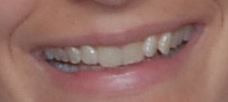
My oldest child did not have a great diet from 0-3 years old. I also did not have the best maternal diet when I was pregnant with her. Starting at age 4, her leaky gut was healed and her diet was awesome. Luckily she has good spacing between her teeth. We have done some palate widening and bite build-up work with her.
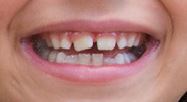
My youngest child has a great diet from birth. She never really had a chance to develop leaky gut. She has great space between her teeth and a very wide palate. All the dentists who see her marvel about her palate width and teeth spacing. I guess they don’t see this much anymore. I’m very curious to see the results when her permanent teeth come in. Stay tuned.

Finding Hidden Cranial Issues
I have found a few very rudimentary tests for a few cranial issues that might arise. These are especially useful when:
- Structural Issues Are Not Visually Obvious – Sometimes cranial structural issues cannot be visually observed. However, they may still be causing symptoms. Bite issues can also be difficult to observe with an untrained eye.
- Midline Bridge – Midline bridges can create all sorts of mysterious health symptoms that may not be obvious [4].
These simple tests are by no means complete, but can perhaps give an idea of some hidden issues with the midline and bite. A good osteopath or chirodontist can be very helpful, and we do have a few on our team. My rudimentary tests can be found on this video, starting at minute 11:49:
Another instructional video shows the midline test starting at minute 5:25. Minute 12:49 shows the frenum.
Treatment Summary
There are lots of treatment options for cranial structural issues. Some are relatively cheap and easy, others are expensive and painful. Some, like conventional orthodontics, can make symptoms worse. There doesn’t seem to be consensus among practitioners on this topic. Every practitioner we saw seemed to have a different opinion about what to treat and how to treat it. Many of their treatment suggestions I had never even heard of!
Let me introduce this motley group of treatments with a list. This is a rank-order list, from most helpful treatment to least helpful treatment. All of these treatments we have completed, some over many years, and some at great expense. More details on each of these are in the following sections, which are linked in each title as well.
- Diet – Fundamentally cranial structural issues stem from the degradation of our diet. Without the proper nutrients and minerals, our cranial structure, jaw, face, and teeth don’t develop properly. Weston A. Price has noticed degradation in structure declining with each generation [1]. For young children there is a ‘relatively’ easy fix – change their diet, heal their leaky gut, and make sure they are digesting properly. Adults are no longer growing, so these changes alone probably won’t affect their physical structure. However, diet will support structural changes made by other means discussed below. In our case, overall our diet and digestion haven’t been too bad, so our structural issues are ‘relatively’ mild.
- Oral Myofunctional Therapy – This requires discipline, but it is relatively cheap and easy. We saw the most bang for our buck with these therapies. Getting the tongue into the proper resting position was a big deal for the three of us who had the improper position. We were generally happier, and had an easier time detoxing and draining. We did the therapy exercises twice per day for about a year. We saw a practitioner approximately once per month during that year. Note that myofunctional therapy may not have been as effective for us without Bite Build-Ups and Frenectomies, the two next items on this list.
- Bite Build-Up – One of our children had a very shallow bite and we had a few practitioners recommend a structural filling build-up on her baby teeth. Wow, the results from this alone were unbelievable!
- Frenectomy – Even though we had no feeding or major speech issues, three of us had frenectomies. The child with the worst tongue-tie had an amazing growth spurt after the frenectomy. This child ended up having a ‘revision’ or second frenectomy. The other two of us who had the frenectomies report feeling and functioning better. Note that we did Myofunctional therapy to help ensure the success of the frenectomies.
- Osteopathic & Chirodontic Treatments –We did these with practitioners. They were helpful and supportive.
- Home Osteopathics – We widened the palate with at-home exercises. We prevented orthodontics and ALF orthodontics.
- ALF Orthodontics – So far we haven’t done any orthodontics or ALF orthodontics. I am wary of conventional orthodontics that don’t consider cranial structure. The ALF is the modern alternative. The ALF is a wire that sits in the mouth to widen the palate. X-rays are taken so ALF orthodontics are designed to take into account cranial structure. This is an expensive and long (several years) path. It is a lot of time and money for an unknown outcome. There are rumors of some practitioners using the ALF who are using it like conventional orthodontics. So far, I have been watching ALF orthodontic outcomes and haven’t seen any great ones. I think we’ve had more success with #1-6 above than I’ve seen others having with ALF orthodontics.
Oral Myofunctional Therapy
Oral myofunctional therapy is used to correct oral function. Oral function is essential to our ability to breathe, eat, drain and detoxify. The tongue, swallow, and bite have an amazing influence on our overall health. We did oral myofunctional therapy twice per day for about one year. We saw a practitioner about once a month during this time. Suffice it to say that we once again spent a lot of time and money on this. We did a lot of exercises, not all of which we found helpful. I’m not sure if we would’ve had the success we did with this had we not also done the Frenectomies and Bite Build-Up. The rest of this section is devoted to the pieces of myofunctional therapy where we really got a lot of bang for our buck (and for our time!).
For us, the big win was in getting the tongue functioning properly and in the correct resting position. The second biggest win was in a breathing exercise called Steps. Our third big win was in the exercises that prepared us for successful frenectomies. These pre-frenectomy exercises are detailed in the Frenectomy section.
Tongue Up – Getting the Tongue on the Roof of the Mouth
First up is getting the tongue on the roof of our mouth – when resting, swallowing, and breathing. Getting the tongue functioning and resting properly is essential to development of the oral cavity, especially in children. I have observed clinical improvements in both children, in terms of oral development, moods, and increased vitality. I also feel much stronger myself, although it’s nothing that I can quantify. It’s possible for adults to also obtain small shifts their oral structure with therapy; on the order of millimeters. The results are often more pronounced and actually visible (!) in children.
The tongue should always be on the roof of our mouths. The correct location is called ‘The Spot.’ The girls and I all had the resting and swallowing position of our tongues on the bottom of our mouth. I’m suspicious this is because we were thumb suckers, but I can’t prove this. The fastest, easiest way for us to get our tongues up was to stick a small ball of “gelatin” on the roof of our mouths in the correct location pictured here:
Our tongue kept playing with the gelatin placed on ‘The Spot’. It was sticky and thick enough that it took quite a bit of time for the tongue to fully dissolve the gelatin. We applied gelatin twice a day, after breakfast and before bedtime. Slowly the tongue spent more and more time on the roofs of our mouths playing with and looking for the gelatin. It took the children about 4 weeks to retrain their tongue, and it took me about 6 weeks. The ‘gelatin’ we used is this strip paste, but I can’t recommend it. By the time I realized that the ingredient list is totally skeptical (Aliphatic hydrocarbon mixture, sodium carboxymethyl cellulose, carbohydrate mixture, and labelled for external use only), we were already done using it. If I could do it over again, I would try to come up with a homemade, sticky gelatin-based recipe.
Buteyko Breathing Exercise – Steps
The second piece of oral myofunctional therapy that I thought was useful was a Buteyko breathing exercise called Steps. Steps is supposed to increase the resting level of oxygen in the blood. The breathing exercises we do are like this Buteyko Breathing Exercise – Steps video, except we do them while walking briskly. We do 6 reps 2x/day, with rest in between. We dropped to 4 reps once we were able to do 6 reps for 40 seconds each. It took us several months to hold the 6 reps long enough. We aim for 80 steps on each round, or about 25 seconds for a 5-year-old and 40 seconds for an adult.
The Steps exercises have been helpful in a way that is hard to describe. I can’t say for sure if we actually increased the resting level of oxygen in the blood. Overall I would say we are stronger and we all have more energy. The book Close Your Mouth: Buteyko Clinic Handbook for Perfect Health was highly recommended to me by a practitioner, but I haven’t checked it out myself.
Bite Build-Up
I thought a dentist was crazy when she first proposed a bite build-up! She wanted to put 4 structural fillings on baby teeth that didn’t have cavities! Sometimes if the bite can get additional depth, this helps the rest of the cranial puzzle fall in to place, the dentist explained. In a child, permanent teeth tend to rise to the same level as baby teeth. So by giving the baby teeth extra depth, you are actually getting a deeper adult bite. She claimed she had also seen cases where the deeper bite caused the jawbone to widen.
The change in our child’s demeanor after the build-up was immediate. She was so happy! I thought I was crazy, but my husband made the same observation – that she seemed much happier after the filling build-up. We noticed in the next week that her lower jaw rapidly came forward. These 4 fillings seemed to have not only changed her structure, but also drastically changed her function. It was a big step forward for her.
She ended up getting a total of 3 bite build-ups. We built the same fillings up slightly higher each time. She had the most improvement after the first build-up, and mild improvements after the next two. We did only a few millimeters at a time to ensure that she could still eat and talk while her other teeth erupted further. Our dentist also said that if too much is done at once, osteopathic problems can develop. We did do osteopathic treatments both before and after the bite build-ups. Here is a picture of her mouth after all the build-ups:
The structural fillings can be seen on Teeth Numbers S,T,L and K. These are two on the right and two on the left, starting right about at the end of her tongue. Notice that the tongue drops at the back permanent molars. The bottom molars didn’t come up as much as the top molars came down. I’m guessing this is gravity at work. It would be great to find a way to get the lowers to come up without expensive and obtrusive appliances to hold the uppers from coming down. Not to mention finding a practitioner to do this. Anyway, the increase in bite depth has definitely improved her health. Regardless of wether the lower molars came up less than the upper molars came down.
Would I have done this on permanent teeth? I’m not sure I would’ve had the nerve to try it. We probably would’ve energy tested with popsicle sticks in the mouth to see if an increased bite would help. Then we would’ve tried a temporary splint or appliance first. Hopefully wearing this device would give us an idea if the increased depth was going to make a difference or not.
Insurance did cover the first build-up, billed as normal fillings. The build-ups after that on the same teeth we had to pay out of pocket. Our feeling is that this was money well spent.
Frenectomy
Sometimes, a frenectomy might be necessary to give the tongue enough mobility to function properly. I thought only babies with breastfeeding problems or people with speech problems had frenectomies! It turns out that they can also be helpful to people who don’t have any of these obvious tongue-tie symptoms.
In a seven year follow up case study, Defabianis (2000) indicated that after a lingual frenectomy there was a spontaneous expansion of the child’s palate which negated the need for orthodontic treatment [4]. The tongue finally had enough movement to rest and function on the top of the mouth. This new tongue position expanded the child’s palate.
Details and pictures of our frenectomy adventures are in the frenectomy section. However, this was so helpful for us that I want to include the highlights again here. The summary is that myself and both children (at ages 4 & 7) had frenectomies. In one child, we noticed a rapid growth spurt after the procedure — approximately 2 inches in height and 3lbs in weight. All within a week. The same child’s upper mandible and lower jaw moved rapidly forward in the first 2 weeks after surgery. Her slurred speech improved too. I can’t resist copying her picture here:
I can’t resist copying this Improvement Summary table from the frenectomy section. We did pre and post frenectomy myofunctional exercises, which I believe significantly contributed to our impressive results.
Improvements with Frenectomy
| Age of Person | Methylation Mutation (s) | Type of frenectomy | Slurred Speech | Development of Jaw/Face | Growth Spurt | Hunch-Back Posture | Overall Good Mood & Happiness |
| 4-5 (Youngest Child) | C677T / C677T | T, LB | + | +++ | +++ | +++ | |
| 7-8 (Oldest Child) | C677T / A1298C | L, LB | ++ | + | |||
| 38-40
(Me) | C677T | T (L done in car accident) | +++ | + | |||
| 41-43 (Husband) | C677T / A1298C | Didn’t need any |
T= under the tongue, a.k.a lingual
L= holding the lip in the front, a.k.a labial
LB = holding the lip on the side, a.k.a labial buckle
+ = slight improvement
++ = major improvement
+++ = unbelievable improvement
Osteopathic & Chirodontic Treaments
Osteopathic and chirodontic treatments can also help with cranial structural issues. We definitely feel better after treatments. Although I can’t quantify it, I have noticed the children walking, functioning, detoxing and draining better. Personally I have seen a total of 5 osteopaths and 1 chirodontist. They all have different techniques and I seem to get some benefits from each of their unique skills.
I have also seen a total of 7 chiropractors, but found them overall less helpful for chronic problems. The one exception is a chropractor who does endonasal cranial adjusting with a balloon. This technique can be absolutely transformative.
I would definitely see an osteopath or chirodontist under these conditions:
- Before and after any major bridge or dental work.
- Before and after frenectomy.
- Difficulty detoxifying or draining.
- Headaches.
- Autism.
- Accidents.
Unfortunately I can’t report that osteopathy solved the root cause of our problems (hidden dental infections, parasites, leaky gut, lyme, etc). It did help support us as we healed, and made us feel a lot better.
Home Osteopathic Exercises to Widen the Palate & Avoid ALF Orthodontics
When a few different practitioners said that our oldest daughter’s jaw wasn’t wide enough, I could see that they were right. I was hoping that with her filling build-up, the jaw would widen. It did widen a little bit, but not enough. They all seemed to agree that she needed an ALF, an orthodontic appliance to widen the palate.
Here was my thinking: If oral myofunctional therapy could help our tongue get into the right position, why couldn’t it widen her palate? Maybe we just needed some new exercises. The oral myofunctional therapist wasn’t convinced. She still said we needed an ALF orthodontic appliance. I wouldn’t give up trying to find a less expensive, less invasive, and faster solution.
If I massaged the upper and lower mandible in the outward direction twice a day, wouldn’t it widen? Especially in a 7-8 year old who is still growing quite a bit. The ALF basically puts pressure on the palate all day long to encourage it to widen. I started massaging. Finally one of the osteopaths got on board. She showed me the proper way to massage that goes with, instead of against, the development of the mandible. Here is the general idea:
- Feel for areas in the upper palate that are narrow. Use two thumbs and feel in an outward direction.
- Massage any narrow areas from the top of the palate down towards the teeth. Sometimes it helps to put the thumb knuckles together for leverage.
- Massage about 10 times twice per day.
- Feel for areas in the lower mandible that are narrow. Again use the two thumbs.
- Massage any narrow areas from the middle of the lower mandible upwards towards the teeth. Hang out for a few seconds using outward pressure on any spots that feel narrow or stuck. Apply pressure evenly, even if only one side feels narrow.
- Massage about 10 times twice per day.
Here are pictures illustrating steps #2 and #5. We massage the upper jaw first, then the lower. This is because of an unproven theory that the lower jaw tends to follow the upper. The thumbs rotate in the direction of the arrows.
Massaging the narrow areas of the upper jaw first, thumbs go in the direction of the arrows:

On the lowers, the thumbs rotate in the opposite direction:
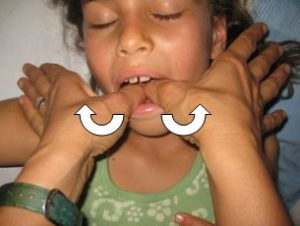
It took about 3 months of massaging twice a day before all practitioners agreed that she no longer needed an ALF, or any palate-widening orthodontics. I still massage a few times a week, just to make sure development is still heading in the right direction. This was a lot cheaper, faster, and easier than an ALF or orthodontics. Here is a picture before and after the exercises.
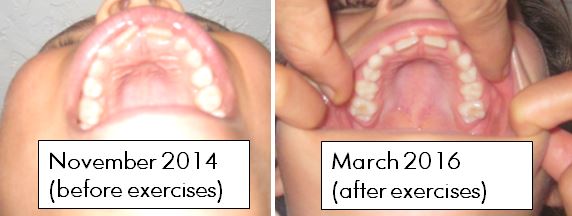
The changes are subtle to see in the picture. Look at the palate arch closely – it is a bit wider. Notice how the front tooth has straightened out. The area in the front has really widened, and she now has large gaps between her teeth. The space between the very back molars looks still a little tight. I’ve just started exercises again, working more on that back area.
We were under osteopathic care before, during, and after the 3 months of these massaging exercises. This was to help ensure that the other cranial bones were moving along with the expanding palate. Overall, in this child, the other cranial bones seemed to be moving well without further intervention. There were no major issues that needed correction. It’s unclear to me if this would be true in an adult. I would definitely still have a good traditional osteopath double checking cranial movement as the palate widens.
ALF Orthodontics
A dentist has recommended bite work to help my cranial structure – both an increase in the height of the bite, and an ALF orthodontic device to widen the maxilla (a.k.a upper jawbone) and lower mandible. I did have TMJ X-rays done and my TMJ joint looks fine. I agree that my maxilla is not as wide as it should be, and that my lower jaw is too retruded. However, do I really need expensive ($12k) and long-term (2-3 years) of orthodontics to feel better?
Another option proposed is a temporary appliance, a.k.a night guard or splint that can be custom fit from a dentist. Some of them are just for night time, but some can also be used for chewing. This is a relatively inexpensive way to ‘try out’ if the orthodontic work might be helpful or not. In my case, I already had a splint made for me years ago for teeth grinding (Parasites, I learned later, were the root cause of my teeth grinding). I did not notice any improvement in my health when my bite was temporarily ‘raised’ with the splint. I have now learned to energy test to see if a splint might be useful. This is even less expensive than actually getting a splint. My rudimentary tests can be found on this video, starting at minute 11:49:
As mentioned in the previous section, ALF orthodontics was also recommended for my oldest child. It is no longer recommended after the palate widening exercises described above.
As for my case, it turns out the symptoms I had at that time resolved with cavitation surgery. I also experienced increased overall vitality after frenectomy. It’s unclear if the frenectom itself was the reason, or if it was because my tongue was finally permanently up instead of down after the procedure. A narrow palate wasn’t the source of my problems after all!
For now, none of us have done any ALF orthodontics or conventional orthodontics. Note that our cases were ‘relatively’ mild compared to some other cases I’ve seen. It would be interesting to do a clinical, quantitative trial on the Home Osteopathic techniques. I wonder if the exercises, combined with diet and healing leaky gut, can widen the palate and help correct cranial structural issues — even in severe cases.
FAQ
No questions yet. Ask away!
References
[1] Weston A. Price MS DDS FAGD, “Nutrition and Physical Degeneration,” 1939.
[2] Dr. Raymond Silkman DDS, “Is it Mental or is it Dental?” March 2006.
[3] Sally Fallon Morell, “Ancient Dietary Wisdom for Tomorrow’s Children,” 2000.
[4] Dr. Gerald H. Smith, “Dental Bridgework May Be the Source of Your Patients’ Headaches, Neckaches and Facial Pain.”
[5] Defabianis P. (2000) Ankyloglossia and its influence on maxillary and mandibular development. (A seven year follow-up case report). Funct Orthod. 17(4):25-33.
Was this information useful? If so, please consider donating to keep this site alive.
Last Updated:


